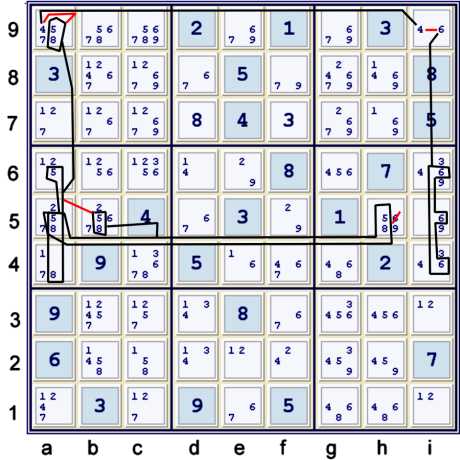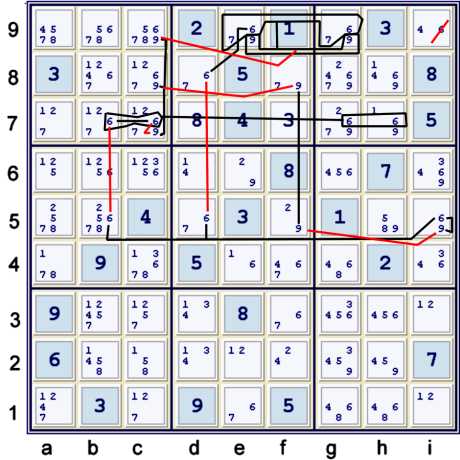Welcome back!
This proof is multi-page. Hopefully, you have already digested the
First Page.
This page contains a few interesting ideas for study. All of them are the natural result of
viewing Forbidding Chains or Alternating Inference Chains (AIC)
with sufficient generality, but strict logical precision.
First, however, I will dispense with one relatively easy step.
Finned X Wing with candidate 9

Above, the possible locations for candidate 9 form a standard finned X wing. As a forbidding
chain on candidate 9:
- e6 == e9 -- i9 == i56 => g6≠9
In an attempt to mimimize the number of strong inferences used to justify eliminations, I have
become somewhat adept at finding Hidden Pairs. The natural inclination, then, is to be adept
also at using Almost Hidden Pairs. The Almost Hidden pairs used below are a bit unusual.
Usually, only one of the two potential hidden pair candidates need be considered to argue
Almost Hidden Pair.
Almost Hidden Pair 58 and Almost Hub Spoke Rim within a chain

Again, the graph of the chain is a bit confusing. As a forbidding chain, this step could
receive the following representation:
- Let A = {a45=8 and a56=5}
- One could also say: Let A = {a456 contains both 5 & 8}
- i9=4 == a9=4 -- a9=58 == A -- b5=58 == {Hidden pair 58 at ah5} -- h5=9 == i56=9
Compound arguments are used frequently in Sudoku. Even the relatively easy finned X wing uses
a compound argument. The form used above to justify the Almost Hidden Pair is a bit more unusual,
as it considers that a9=4 forbids both a9=5 and a9=8, and then that both 5 and 8 would be locked
within box b5 and column a, which then reveals the Hidden Pair argument.
A similar compound argument can generally be made to view Sue De Coq as Hidden
Sue De Coq. Oftentimes, the hidden argument regarding Sue De Coq is much simpler
(for me only perhaps?). I suppose I am digressing....
My standard puzzle marks would not indicate this chain very strongly. Of course a puzzle such
as this one requires a bit stronger analysis. The puzzle marks advocated in later blogs, however,
does indicate this chain. To wit:
- cell a9 would have the 4 circled, and both 5 and 8 underlined.
- Cell i9 woould have the 4 circled, and both 6 and 9 underlined.
- cell h5 would have the 5 circled, the 8 circled, and both the 5 and 8 underlined.
The interesting point here are the 5s and 8s. Upon inspection of the puzzle markings, it is
clear that
- h5=69 -- h5=58 == ab5=58 -- a456=one of 58 == a9=one of 58
A chain snippet such is this is often a useful building block in a larger chain. The concept is
truly an almost Hidden Pair, as it relies on the fact that candidates 58 are limited to three
locations in row 5. What makes the pattern very interesting, to me, is the additional almost pair
58 at a59. Thus, what I see in my head to indicate the existence of this elimination group is:
- h5=58 == {a5=58,b5=58,a9=58}
- Thus, h5=58 == a9=58
This is sort of a grouped hinge. It is really no different from a standard coloring hinge, except
that it employs a grouped argument, in this case, 58 versus a single candidate. This is one of
the reasons that I strongly advocate thinking in groups, and prefer to not limit my thinking to
only bivalue or bilocation types of processes. It is also why I advocate studying coloring, as
the same thought process as coloring is applied here, except that it is applied to a group.
This begs a different representation of the same elimination:
- a9=5 == a56=5 and a9=8 == a45=8 and abh5=58 represent a grouped hinge:
- i56=9 == h5=9 -- h5=58 == a9=58 -- a9=4 == i9=4 => i9≠9
Oftentimes, the bare representation of the AIC does not reveal the thought processes that
occur to locate the chains. I thought perhaps a window into my addled mind might be helpful!
Regardless of nomeclature, the key to very complex chains, and very difficult sudokus, can
be summarized rather succintly: Employ the use of grouped arguments.
Another interesting way to view the same elimination above is the use of the
Almost Hub Spoke and Rim created by the 58s in column a and 58 at b5 versus 58 at h5.
This would appear as follows:
- a9=5 -- a9=8 is a potential hub
- a9=5 == a56=5 is a spoke
- a9=8 == a45=8 is a spoke
- b5=58 is the potential rim
Of these conditions, we are lacking the rim. So, merely combine this potential rim with the
Almost Hidden Pair 58 in row 5 at abh5. Now we have:
{a9=5 == a56=5 -- b5=5 == b5=8 -- a56=5 == a9=8} == {Hidden pair 58 at ah5}
this reduces to: a9=58 == h5=58
This leaves us with a perfectly viable strong inference, and now we can insert this relationship
into the macro chain as noted above.
If you need yet another way to view this chain, clearly it is also an Wrap-around Y Wing Style
combined with an Almost Hidden Pair, used in a chain. For avid blog followers,
perhaps this last interpretation makes the most sense. In any event, the wrap around Y Wing Style
is, in this case, precisely the same as the Hub Spoke Rim configuration.
Of some interest is that the complex chain from the earlier page made most of the eliminations
required to produce the relationships used here, as one needs the following sets proven strong
from that chain:
- a9=4 == i9=4
- a45=8 == a9=8
Atypical Almost Hidden Pair 58 within a chain - AGAIN

Using almost exactly the same strong inferences, another elimination is available. Let A be
described as the Almost Hub Spoke Rim Hidden Pair configuration previously detailed. Thus
A, for the purposes of this chain, is equivalent to a9=58 == h5=58:
- i456=6 == i9=6 -- i9=4 == a9=4 -- a9=58 ==using A h5=58
There is some potential for some uniqueness arguments to be made here using the 58's. However, I
am almost sure that those arguments are at least as deep, if not deeper,
than what I will use. Moreover, I prefer to prove uniqueness of solution.
At this point, there are several ways to prove any of the following:
What follows is the most efficient way that I found to eventually prove all of these.
Almost Coloring X Almost AIC

As complex as the graph above may appear, the base idea is very simple. It is completely
analagous to the idea of Almost Locked Sets, which use a restricted common (a mutual weakness) to
prove a strength. Here, the mutual weakness is centered in cell c7, and involves weakness within
a cell, rather than a mutually weak candidate. Two almost chains pass through that cell, and
only one or the other can exist. Here is a potential representation of the very messy
illustration above:
- Let A = {i5=6 == i5=9 -- f5=9 == f8=9 -- c8=9 == c9=9 -- eg9=9 == {eg9=pair67}}
- Let B = fc on 6's: i5 == d5 -- d8 == e9
- Let C = fc on 6s: B == b5 -- b7 == gh7
- A == c7=9 -- c7=6 == C => i9≠6
Basically, C exists but for the 6 at c7. One potentially has a somewhat complex, but not too
deep, coloring elimination with candidate 6. The endpoints of that chain are i5,e9,gh7.
At least one of those is 6, or c7=6.
Also, A exists but for the 9 at c7. One potentially has a fairly typical chain using the
Almost Locked Set 679 at eg9. The endpoints of that chain also involve candidate 6, and
prove candidate 6 must exist at one of i5, eg9 or c7=9.
Clearly, c7 is not both 6 & 9, so 6 must exist in at least one of {i5,eg9, gh7}. The only
intersection point of those 5 locations happens to contain a 6, and is thus reduced.
This elimination is not nearly as pretty as the other ones presented thus far. It is also
much more difficult to find, as it does not have many markers. The fact that two potential chains
intersect at c7 is fairly obscure. I wish I could reveal how I found this one in some sort of
satisfying detail. Instead I can only offer the following.
I had almost given up on finding a truly logical, technique based, presentable, and educational manner to further this puzzle. A few days later,
while driving my sons to and fro with their wrestling, this puzzle worked its way back into my
head. Suddenly I could see it...! I had focused previously on the 4s and 58s. I know that whenever one group has a very
interesting interrelationship that another group has a roughly mirrored relationship somewhere on
the puzzle grid. It occurred to me that candidates 69 formed such a mirroring group, and that
in fact many of the eliminations derived from the relationship of 458 were upon 69. As soon
as I decided to look at 69 as a group, I saw the pattern illustrated above.
I know that description may be of little practical use, but the main idea here is that often
thinking in groups is very useful. But for the 7s at eg9, this entire pattern is nothing but 6s
and 9s.
After i9≠6, one can finally solve come cells: i9,a1,b8=4.
This concludes the second page of this puzzle proof. The hardest and most interesting parts
of this proof are finished. What remains is the clean up! The beginning of that process
can be viewed on the
third page.